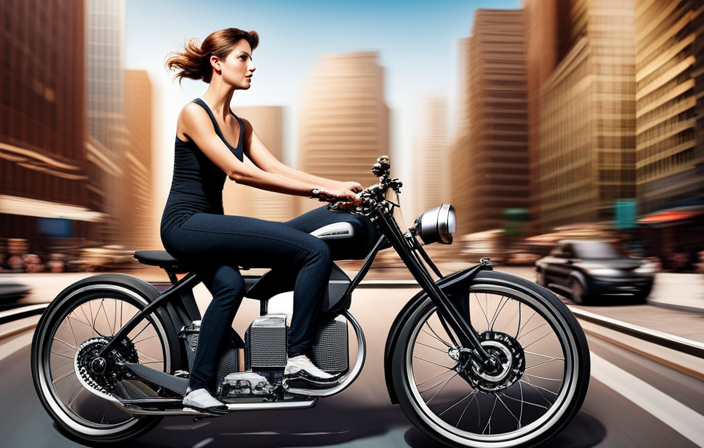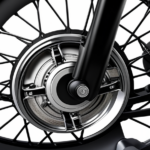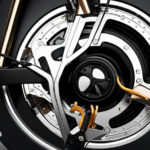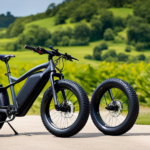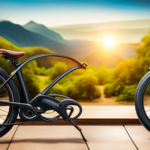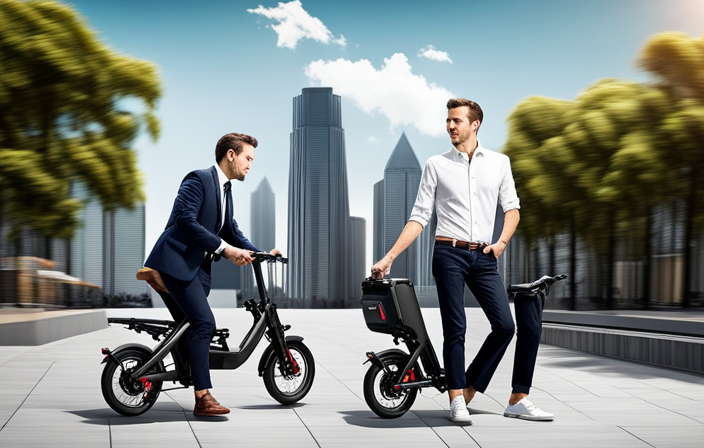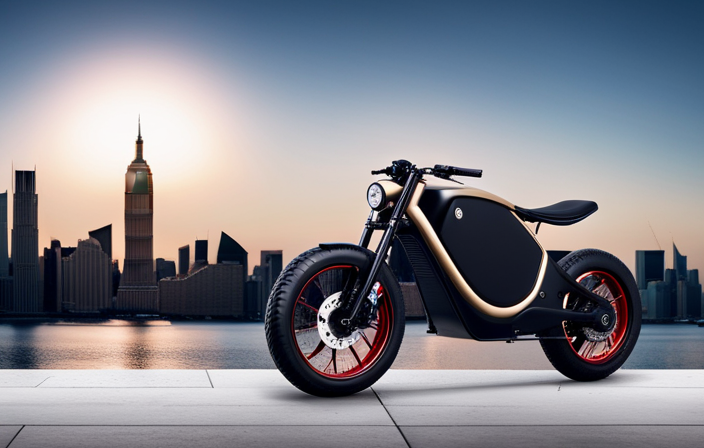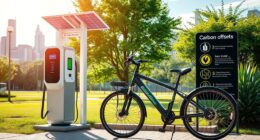I gotta admit, it’s pretty frustrating when my American Flyer electric bike starts making high-pitched noises while I’m coasting. But don’t worry, I’ve got you covered.
In this article, I’ll walk you through the common causes of this issue and give you some tips on how to fix it.
From checking the brake pads and wheel bearings to inspecting loose components, we’ll make sure your ride is as smooth and quiet as possible.
So, let’s dive in and get your bike back in top shape!
Key Takeaways
- Proper posture and balance are important for riding an electric bike.
- Regular maintenance and troubleshooting can help address common issues such as noise.
- Seeking professional assistance may be necessary for complex problems.
- Testing the bike on different surfaces and speeds helps gauge its performance and efficiency.
Common Causes of High-Pitched Noise While Coasting
If you’re hearing a high-pitched noise while coasting, it could be caused by a few common issues. One of the most common causes of squeaky brakes is worn-out brake pads. These pads can become thin over time and create a squealing sound when they come into contact with the brake rotor.
Another factor that can contribute to high-pitched noise is your riding style. If you frequently apply your brakes forcefully or ride with excessive speed, it can increase the noise levels of your bike. It’s important to be mindful of your riding habits to minimize noise.
To address this issue, it’s recommended to check the brake pads for wear and tear. By ensuring they are in good condition, you can reduce the high-pitched noise while coasting.
Check the Brake Pads for Wear and Tear
Check the brake pads for any signs of wear and tear. Proper inspection of brake pads is crucial when troubleshooting brake noise. To ensure your brake pads are in good condition, follow these steps:
| Checkpoint | Action |
|---|---|
| Thickness | Measure the thickness of the brake pads. If they are below the manufacturer’s recommended minimum thickness, they should be replaced. |
| Wear Indicator | Look for wear indicators on the brake pads. These are small metal tabs that will make contact with the brake rotor when the pads are worn down. If you see these indicators, it’s time to replace the brake pads. |
| Even Wear | Inspect the brake pads for even wear. Uneven wear could indicate a problem with the brake caliper or other components. |
Inspect the Wheel Bearings for Any Damage
Now, let’s take a look at the wheel bearings to see if there’s any damage. Wheel bearings play a crucial role in the smooth operation of your bike’s wheels.
Here are some key things to consider when inspecting the wheel bearings:
-
Wheel Alignment: Check if the wheels are properly aligned. Misaligned wheels can put extra stress on the bearings, leading to premature wear and damage.
-
Bearing Lubrication: Ensure that the wheel bearings are properly lubricated. Insufficient lubrication can cause friction and heat, which can damage the bearings over time.
-
Listen for Unusual Noises: Pay attention to any unusual noises coming from the wheel area. A grinding or squeaking sound may indicate damaged bearings.
By thoroughly examining the wheel bearings for damage, alignment, lubrication, and listening for any unusual noises, we can ensure the optimal performance of the bike.
Now, let’s move on to the next section and look for loose or misaligned components.
Look for Loose or Misaligned Components
Let’s start by examining for any loose or misaligned components. When it comes to proper bike maintenance, it’s crucial to ensure that all the parts are securely in place. Begin by checking the handlebars and stem, making sure they are tight and aligned with the front wheel.
Next, inspect the seat post and saddle, ensuring they are properly tightened and positioned. Don’t forget to examine the pedals, crank arms, and bottom bracket for any signs of looseness. Loose or misaligned components can cause unnecessary noise and affect the bike’s performance.
By troubleshooting these tips, you can identify and fix any issues before they escalate.
Now, let’s move on to the next section and check the chain and sprockets for proper lubrication, as this can also contribute to a smooth and quiet ride.
Check the Chain and Sprockets for Proper Lubrication
Make sure you’ve properly lubricated the chain and sprockets to ensure a smooth and quiet ride. Proper lubrication is essential for good chain maintenance and overall bike performance. Without it, your bike may experience increased friction, which can lead to excessive wear and tear on the chain and sprockets. To help you understand the importance of proper lubrication, here is a table that highlights the benefits of regular chain maintenance:
| Benefits of Proper Lubrication | |
|---|---|
| 1. Smooth and quiet ride | 2. Reduced friction and wear |
| 3. Improved shifting performance | 4. Longer lifespan of components |
| 5. Enhanced overall bike performance | 6. Minimized risk of chain breakage |
Examine the Motor and Electrical Components for Issues
To ensure a smooth and safe ride, check the motor and electrical components for any potential issues that may affect the performance of your bike. Here are some important points to consider:
-
Motor Performance:
-
Listen for any unusual noises coming from the motor while it is running. A grinding or squealing sound could indicate a problem.
-
Check the motor’s power output. If you notice a decrease in performance or difficulty reaching top speeds, there may be an issue with the motor.
-
Electrical System Troubleshooting:
-
Inspect the wiring for any signs of damage or loose connections. Faulty wiring can lead to intermittent power loss or electrical failures.
-
Test the battery voltage to ensure it is within the recommended range. A low battery voltage can affect the overall performance of the electrical system.
By addressing any motor performance or electrical system issues, you can ensure that your bike runs smoothly and efficiently.
Once you have checked these components, it is important to transition into the subsequent section about ensuring the tires are properly inflated.
Ensure the Tires are Properly Inflated
After examining the motor and electrical components for any issues, it’s important to move on to another crucial aspect of your American Flyer electric bike: the tires.
Properly inflated tires not only provide a smoother and more comfortable ride, but they can also affect the overall performance and noise level of your bike.
To ensure optimal tire inflation, check the recommended PSI (pounds per square inch) indicated on the sidewall of the tires and use a reliable pressure gauge to achieve the desired level.
Additionally, don’t forget to check the battery charge level and motor controller settings. These factors can also contribute to any unusual noises or performance problems you may be experiencing.
Now, let’s consider the terrain and riding conditions to further troubleshoot the high-pitched noise issue.
Consider the Terrain and Riding Conditions
When considering the terrain and riding conditions, take into account the type of surface you are riding on and how it may impact the overall performance of your bike. Riding techniques and bike maintenance play a crucial role in ensuring a smooth and enjoyable ride. Here are some key points to keep in mind:
| Riding Techniques | Bike Maintenance |
|---|---|
| Maintain proper posture while riding to improve balance and control. | Regularly clean and lubricate the chain to prevent rust and ensure smooth shifting. |
| Use appropriate gears for different terrains to optimize performance. | Check and adjust the brakes to ensure they are responsive and provide adequate stopping power. |
| Maintain a steady cadence to maximize efficiency and reduce strain on your legs. | Inspect tires regularly for wear and tear, and replace if necessary. |
| Stay aware of your surroundings and anticipate any potential obstacles or hazards. | Keep the bike clean and check for any loose bolts or parts that may need tightening. |
| Practice braking techniques to ensure quick and controlled stops. | Regularly check tire pressure and maintain proper inflation for a smoother ride. |
Consult the Owner’s Manual for Troubleshooting Tips
After considering the terrain and riding conditions, it’s time to consult the owner’s manual for troubleshooting tips. When I first noticed the high-pitched noise while coasting on my American Flyer electric bike, I turned to the manual for guidance.
It provided me with a list of common issues and their respective solutions. I learned that this noise could be caused by a misaligned brake pad or a loose chain. The manual suggested checking the alignment of the brake pads and tightening any loose bolts. Additionally, it recommended inspecting the chain tension and making adjustments if necessary.
These troubleshooting techniques and maintenance tips allowed me to address the issue effectively. However, if the problem persists or seems more complex, it’s important to seek professional assistance if necessary to ensure the bike’s optimal performance.
Seek Professional Assistance if Necessary
If the problem persists or seems more complex, it’s important to seek professional assistance if necessary to ensure optimal performance of the bicycle. While consulting the owner’s manual and trying troubleshooting tips can be helpful, sometimes the issue may require the expertise of a professional.
Seeking help from a bicycle mechanic or an electric bike specialist can provide a thorough diagnosis and effective solutions. They have the knowledge and experience to identify and address any underlying issues causing the high-pitched noise while coasting. Additionally, they can perform any necessary repairs or adjustments to ensure the bike is in top condition.
Test the Bike on Different Surfaces and Speeds
To get a better understanding of how the bike performs, try testing it on different surfaces and at various speeds. This will help you gauge its efficiency and overall performance. Here are some key benefits of electric bikes and why testing them is essential:
-
Increased Speed: Electric bikes allow for higher speeds than traditional bikes, so testing them at different speeds will give you a sense of how fast and smooth the bike rides.
-
Terrain Adaptability: Testing on different surfaces such as pavement, gravel, and uphill slopes will demonstrate the bike’s ability to handle various terrains.
-
Battery Life: Testing at different speeds and distances will help you determine the bike’s battery life and how far you can go on a single charge.
-
Handling and Stability: By testing the bike at different speeds, you can assess how well it handles and maintains stability.
-
Comfort and Ergonomics: Testing the bike on different surfaces will give you a feel for the comfort level and overall riding experience.
By testing the bike on different surfaces and at various speeds, you can gain valuable insights into its performance and efficiency.
Once you have completed the testing, it is important to check for loose spokes or damaged wheels to ensure the bike remains safe and in optimal condition.
Check for Loose Spokes or Damaged Wheels
As I tested my bike on different surfaces and speeds, I noticed that the high-pitched noise persisted. It was time to move on to the next step of troubleshooting, which involved checking for loose spokes or damaged wheels.
I knew that loose spokes could cause the wheel to wobble and create strange noises, while damaged wheels could result in an imbalanced ride. Taking a closer look, I inspected each spoke to ensure they were properly tightened and secure. Then, I carefully examined the wheels for any signs of damage such as cracks or bends.
By conducting this thorough inspection, I could diagnose if loose spokes or damaged wheels were contributing to the issue.
Moving forward, it was crucial to examine the pedals and crankset for any problems.
Examine the Pedals and Crankset for Any Problems
After inspecting the wheels for damage, I moved on to examining the pedals and crankset for any issues. Here are the three key things to check:
-
Pedal Alignment: I made sure that the pedals were aligned properly with the crankset. If there was any misalignment, I adjusted them to ensure a smooth rotation.
-
Pedal Tightening: Next, I checked the tightness of the pedals. Loose pedals can cause noise and affect your riding experience, so I made sure they were securely tightened.
-
Crankset Inspection: Lastly, I carefully examined the crankset for any signs of damage or wear. This included checking for cracks or bent parts that could potentially affect the bike’s performance.
With the pedals and crankset properly inspected and adjusted, it’s important to consider upgrading to a higher-quality bike chain. This can further enhance the smoothness and efficiency of your ride.
Consider Upgrading to a Higher-Quality Bike Chain
Upgrading to a higher-quality bike chain can greatly improve the smoothness and efficiency of your ride. A higher-quality chain will provide better shifting performance and durability, resulting in a more enjoyable riding experience.
When it comes to upgrading bike accessories, choosing the right bike chain is essential. To choose the right bike chain, consider factors such as its compatibility with your bike’s drivetrain, the number of speeds it can accommodate, and its overall quality and durability. Additionally, selecting the appropriate chain width is crucial to ensure proper engagement with the cassette and chainrings.
Enjoy a Peaceful and Noise-Free Ride with Proper Maintenance
To enjoy a peaceful and noise-free ride, make sure you maintain your bike properly.
Proper bike maintenance is essential for a smooth and enjoyable cycling experience. By taking the time to regularly check and care for your bike, you can avoid unnecessary noise and vibrations that can disrupt your ride.
Not only does proper maintenance reduce noise, but it also extends the lifespan of your bike and improves its overall performance. A noise-free ride allows you to focus on the road ahead and enjoy the tranquility of your surroundings.
It enhances your cycling experience by providing a sense of calm and relaxation. So, take the time to properly maintain your bike and reap the benefits of a noise-free ride.
Frequently Asked Questions
How do I check the brake pads for wear and tear?
To check the brake pads for wear and tear, I regularly inspect them by looking for any signs of damage or uneven wear. This is an important part of maintaining bike components and ensuring safe riding.
What should I do if I find loose or misaligned components?
If I find loose or misaligned components, I should address them immediately to prevent further damage or accidents. Tightening any loose parts and adjusting misaligned components will ensure the bike operates safely and smoothly.
How can I ensure that the tires are properly inflated?
To ensure proper tire inflation, I regularly check the tire pressure using a gauge. This is an essential part of tire maintenance as it ensures optimal performance and helps prevent issues like the high pitched noises while coasting.
What are some troubleshooting tips from the owner’s manual?
To troubleshoot noise issues on an electric bike, refer to the owner’s manual. It provides valuable tips for identifying common electrical problems. Following these guidelines can help in resolving any high-pitched noises while coasting.
When should I seek professional assistance for my electric bike?
When to DIY and when to call a pro depends on the signs of major electrical issues. If you notice any unusual noises or problems with your electric bike, it’s best to seek professional assistance to avoid further damage.
Conclusion
After addressing the common causes of high-pitched noise while coasting on an American Flyer electric bike, such as worn brake pads, damaged wheel bearings, and loose components, it is essential to prioritize proper maintenance.
By inspecting and maintaining various parts of the bike, like the chain, sprockets, spokes, and pedals, one can enjoy a peaceful and noise-free ride.
Remember, a well-maintained bike not only ensures a smooth ride but also evokes a sense of freedom and joy, making every journey more enjoyable.
